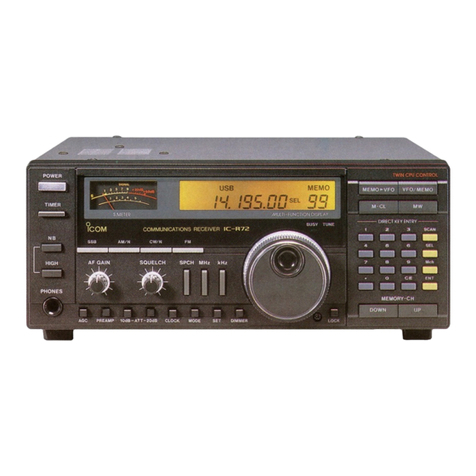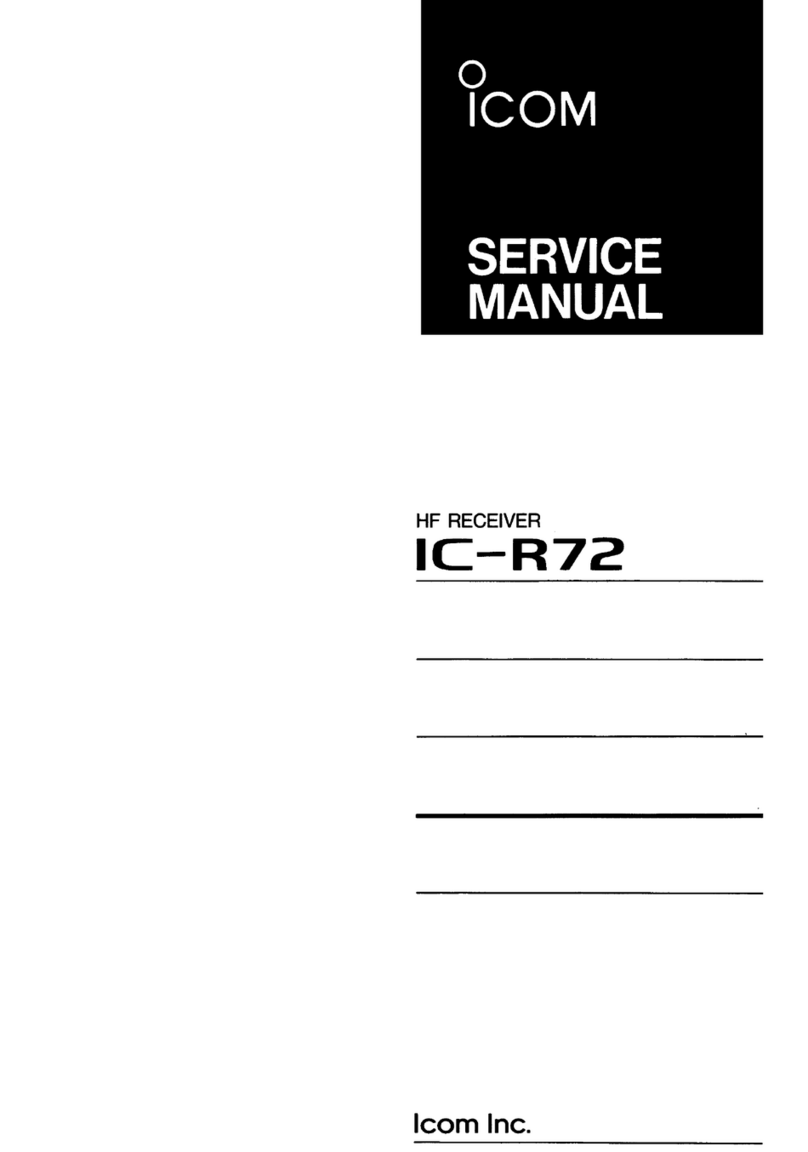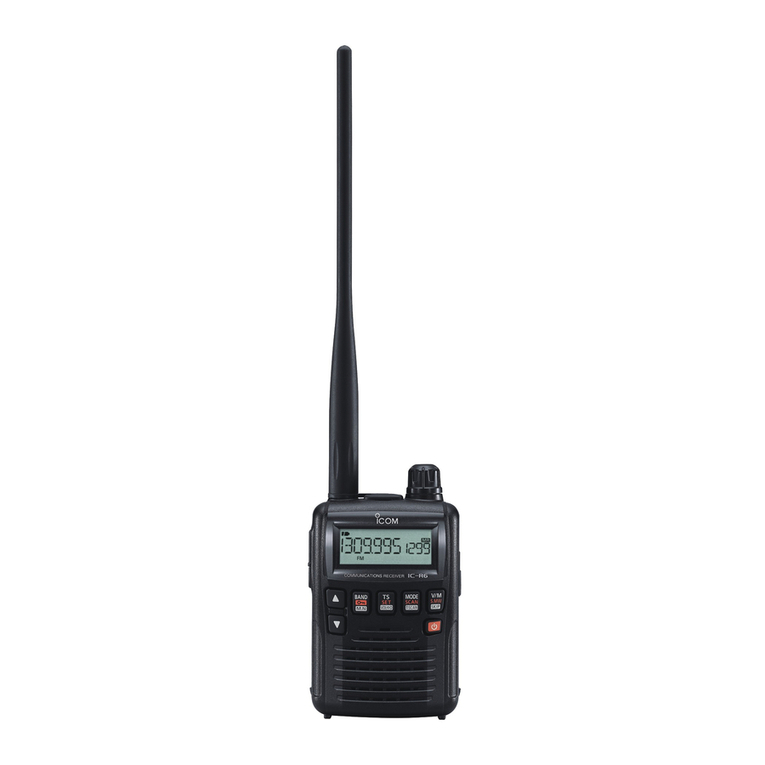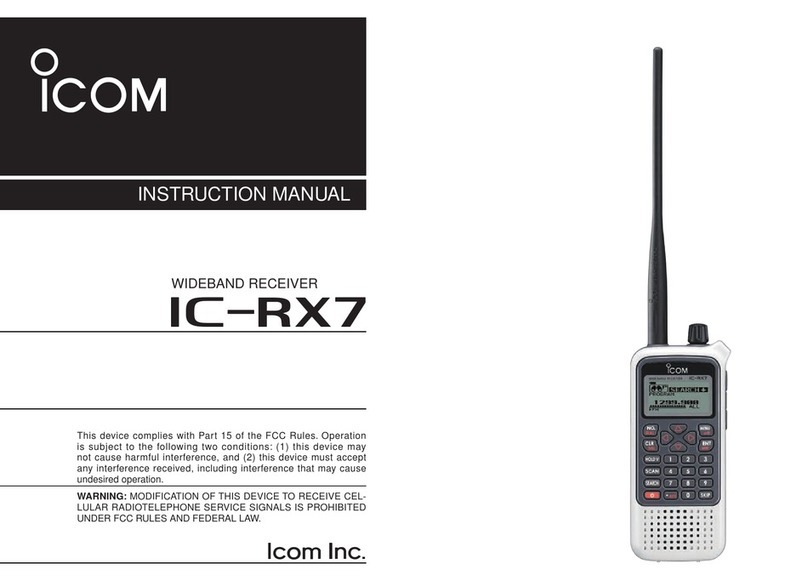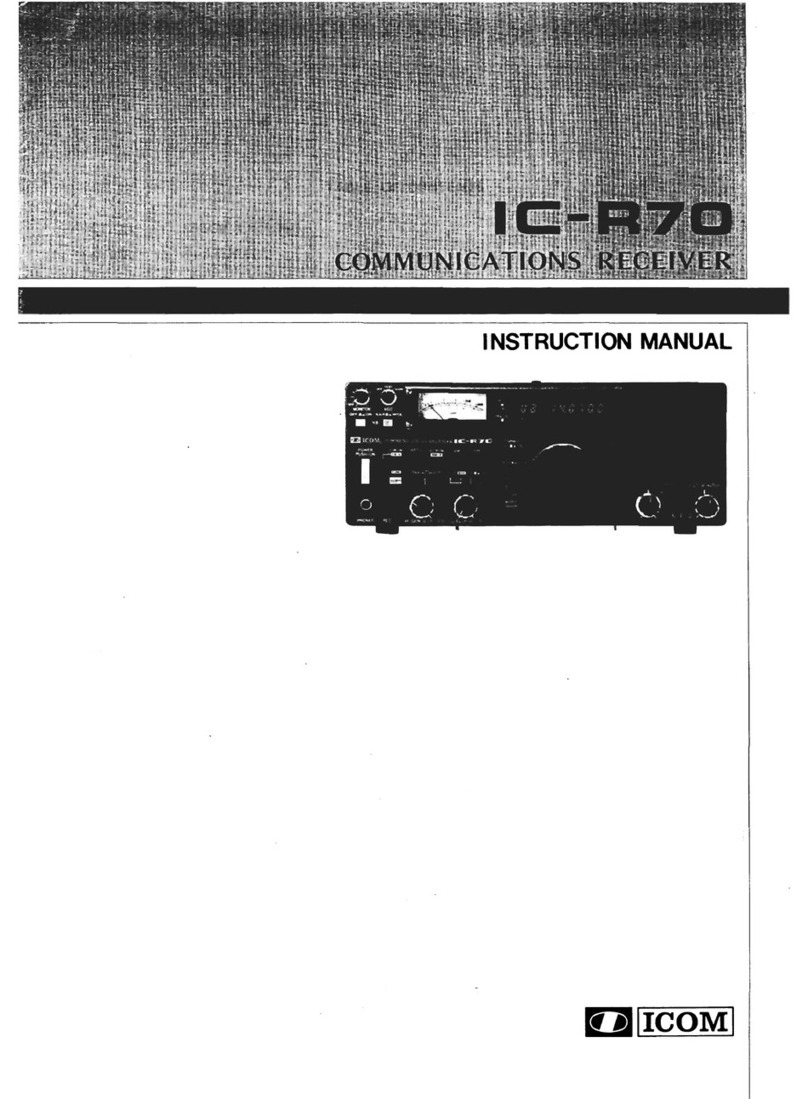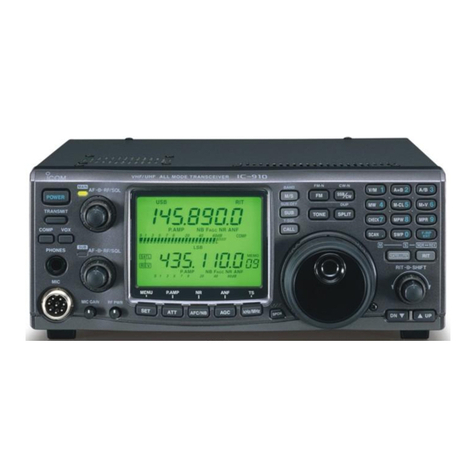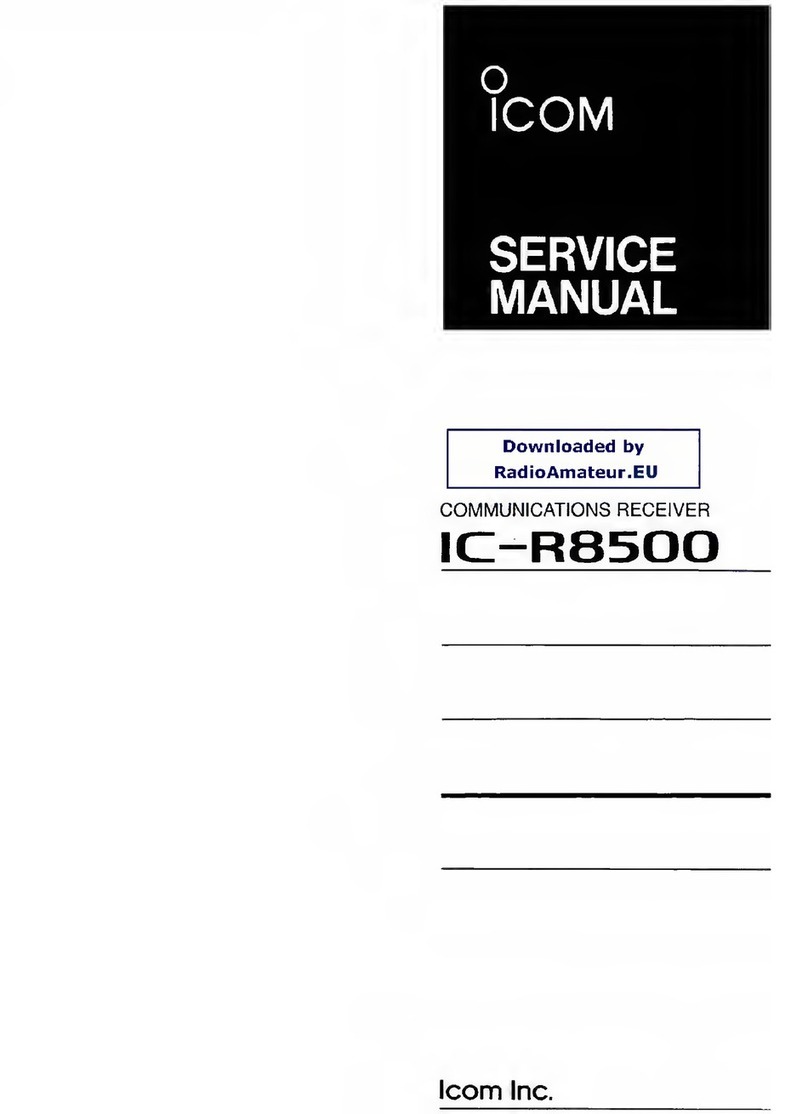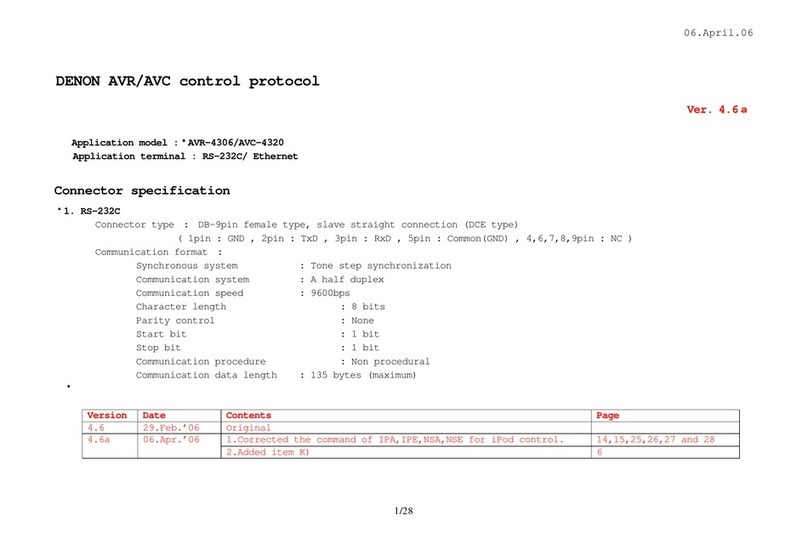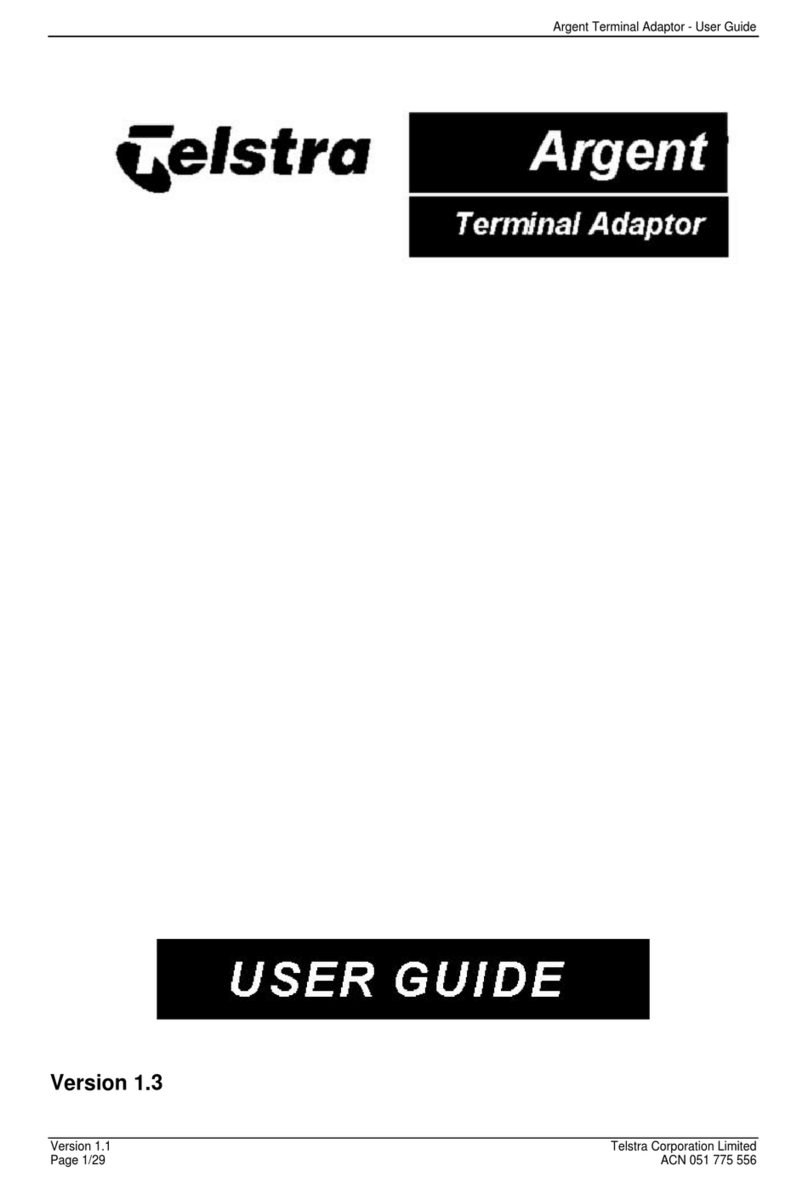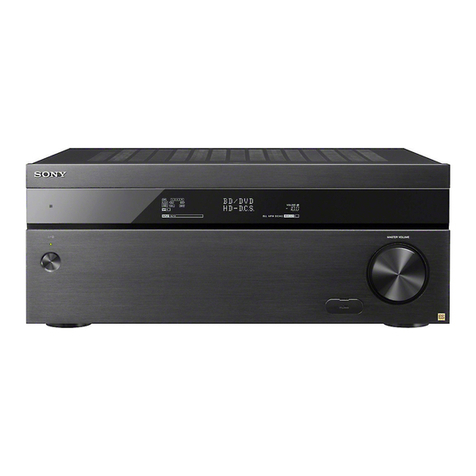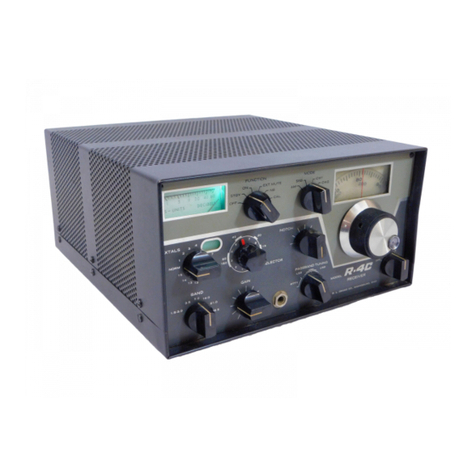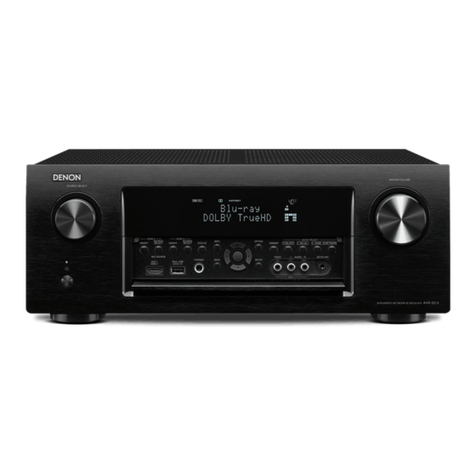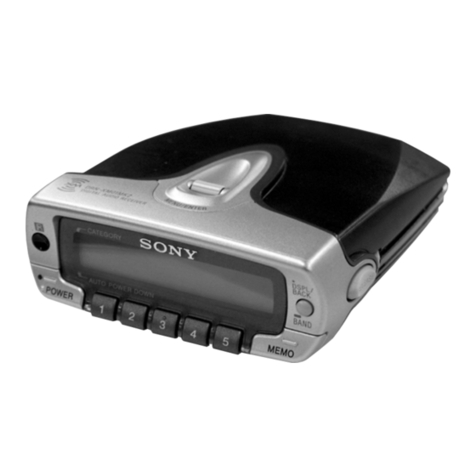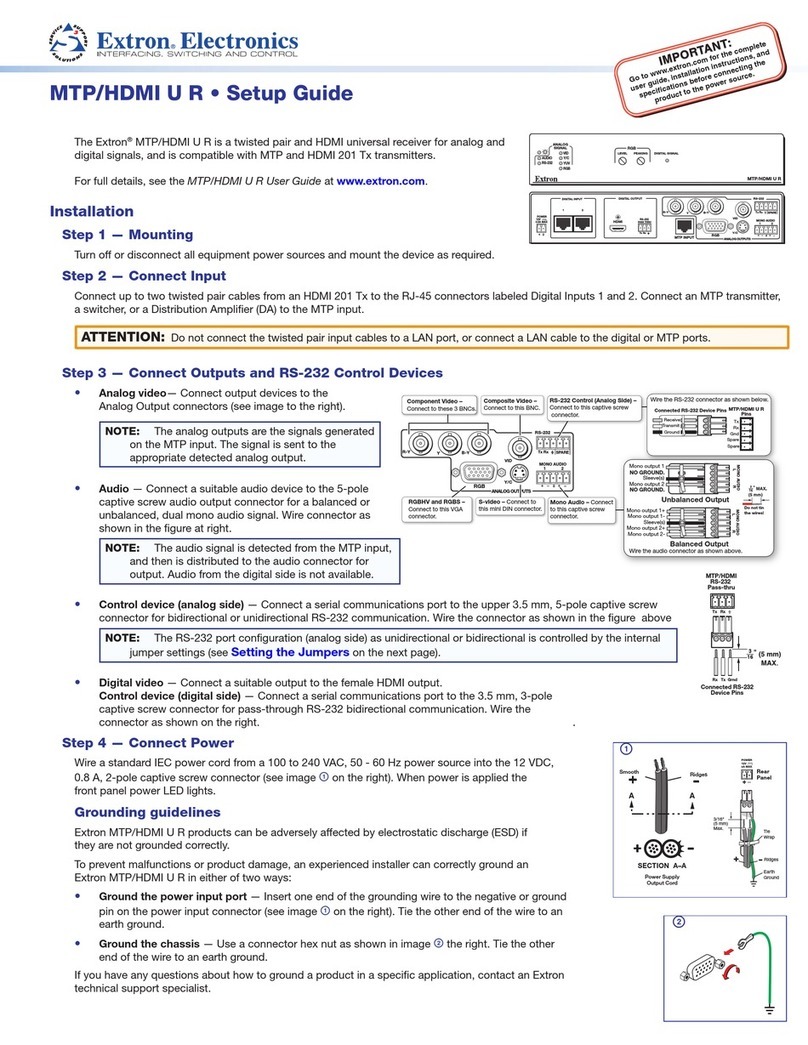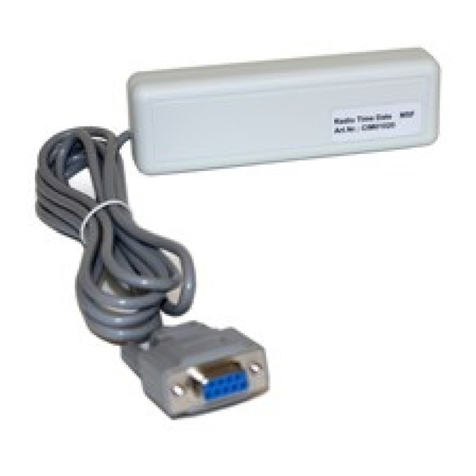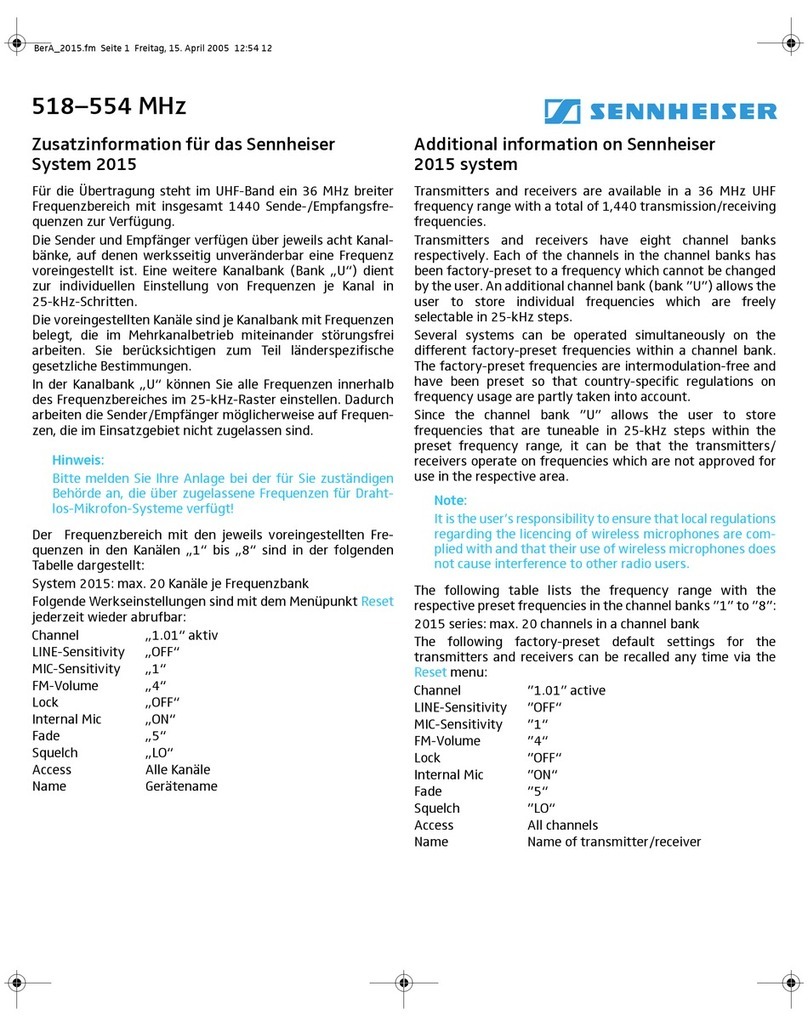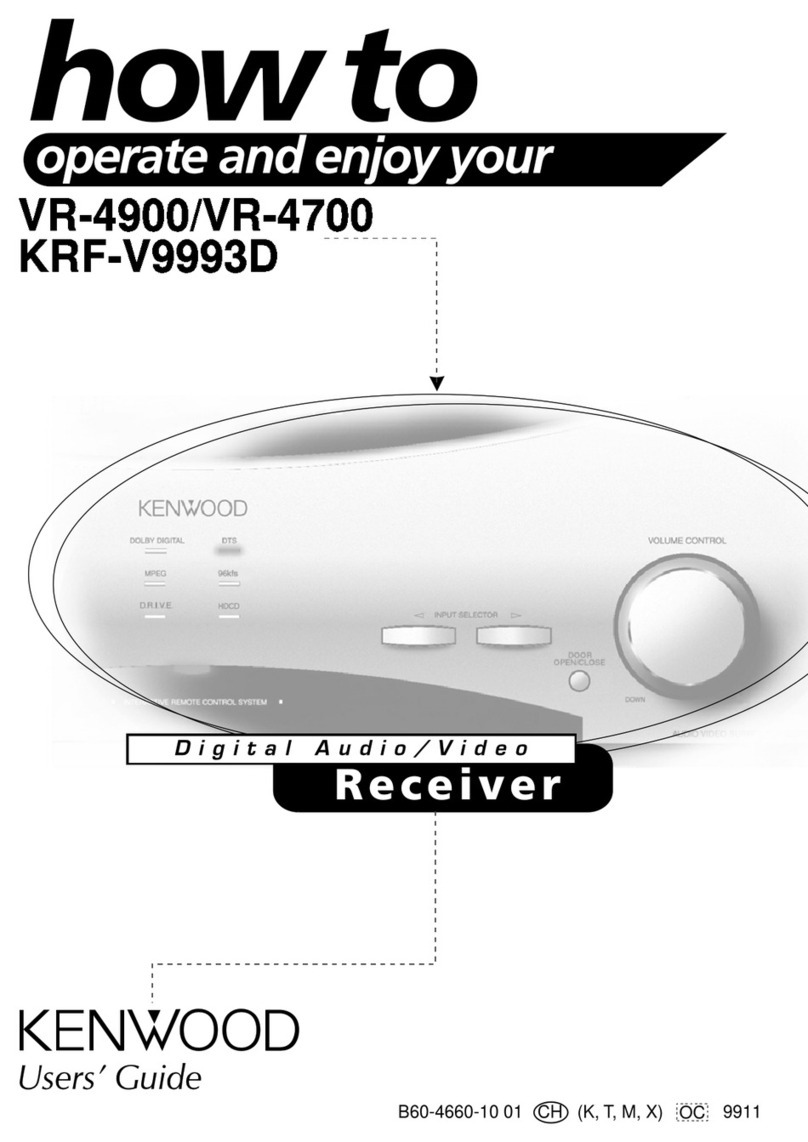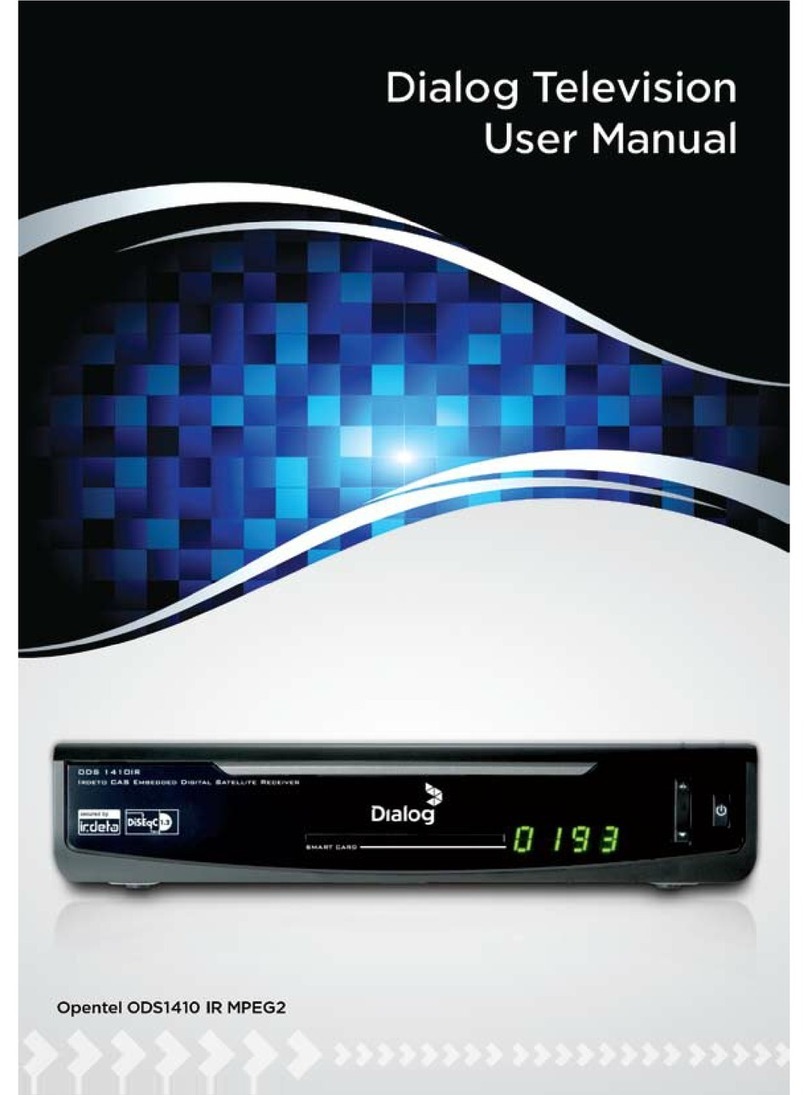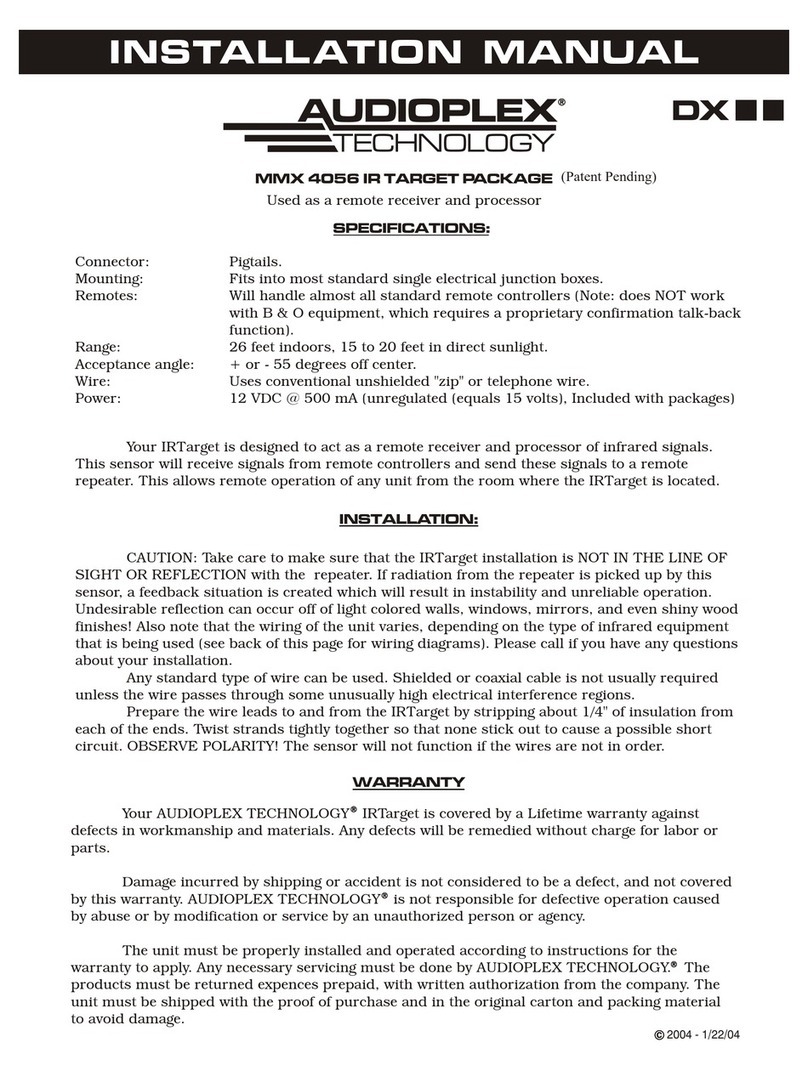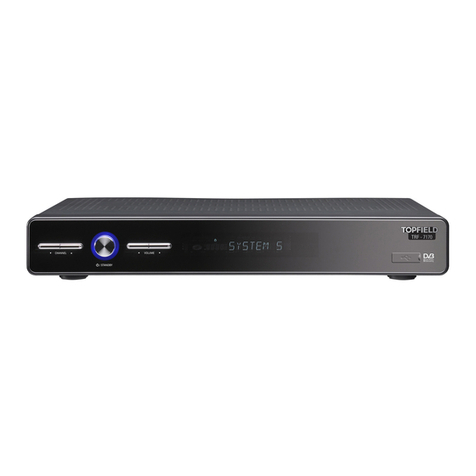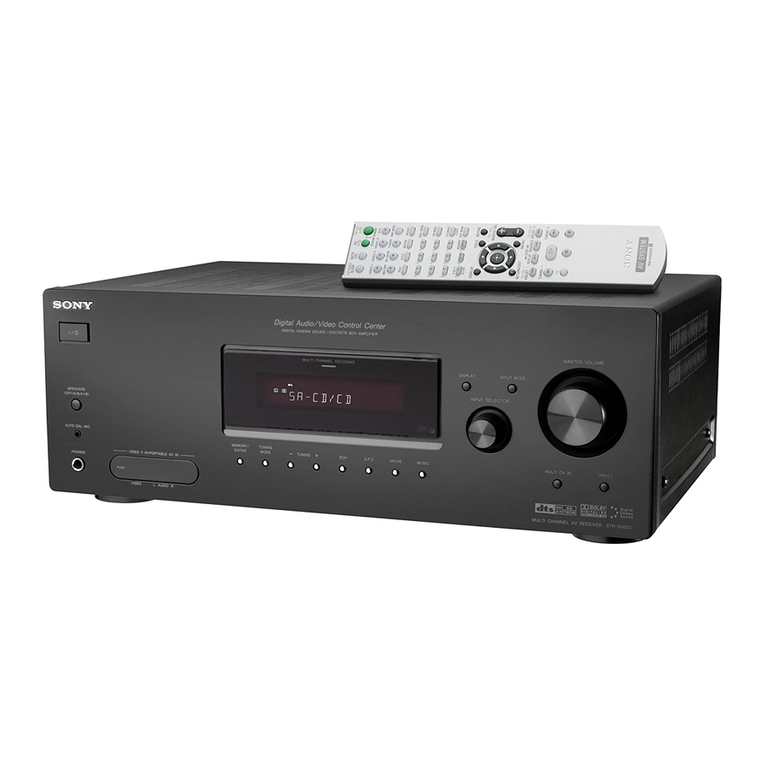Icom IC-A25N Installation guide

VHF AIR BAND TRANSCEIVERS
BASIC MANUAL
iA25N
iA25C
iA25NE
iA25CE

IMPORTANT
READ ALL INSTRUCTIONS carefully and completely
before using the transceiver.
SAVE THIS INSTRUCTION MANUAL — This instruction
manual contains important operating instructions for the IC-
A25N, IC-A25C, IC-A25NE, and IC-A25CE.
For Advanced features and instructions, see the FULL
MANUAL on the Icom website for details.
http://www.icom.co.jp/world/support/download/manual
For IC-A25N and IC-A25NE’s Basic Navigation features and
instructions, see the NAVIGATION GUIDE for details.
i
NOTE:
• Some accessories are not supplied, or the shape is different,
depending on the transceiver version.
• Conrmbothbatteryslidinglocksarelockedinplace,when
attachingthebatterypackorthebatterycasetothetransceiver.
Bothslidinglocksmakea‘click’soundwhenlocked.
• Beforeusingthetransceiverforthersttime,thebatterypack
must be fully charged for optimum life and operation. See
Section 2 for battery charging.
SUPPLIED ACCESSORIES
Antenna
Belt clip
Headset adapter Power adapter
(For Battery charger)
Handstrap Batterypack
Battery charger
ThankyouforchoosingthisIcomproduct.
ThisproductisdesignedandbuiltwithIcom’sstateof
the art technology and craftsmanship. With proper care,
this product should provide you with years of trouble-free
operation.
Battery case
EXPLICIT DEFINITIONS
WORD DEFINITION
RDANGER! Personal death, serious injury or an
explosion may occur.
RWARNING! Personalinjury,rehazardorelectricshock
may occur.
CAUTION Equipment damage may occur.
NOTE
Ifdisregarded,inconvenienceonly.Noriskof
personalinjury,reorelectricshock.

CAUTION: DO NOT expose the transceiver to heavy rain, and
never immerse it in water. The transceiver meets IP57 requirements
for dust-protection and splash resistance. However, once the
transceiver has been dropped, dust protection and splash
resistance cannot be guaranteed due to the fact that the transceiver
maybecracked,orthewaterproofsealdamaged,andsoon.
DO NOT place or leave the transceiver in direct sunlight or in areas
withtemperaturesbelow–10°C(–14˚F)orabove+60°C(+140˚F).
Keep the transceiver in a secure place to prevent use by
unauthorizedpersons.
ii
R DANGER! NEVERshorttheterminalsofthebatterypack.
Shorting may occur if the terminals touch metal objects such
asakey,sobecarefulwhenplacingthebatterypacks(orthe
transceiver) in bags, and so on. Carry them so that shorting cannot
occur with metal objects. Shorting may damage not only the battery
pack,butalsothetransceiver.
R DANGER! NEVERuseorchargeIcombatterypackswithnon-
Icomtransceiversornon-Icomchargers.OnlyIcombatterypacks
are tested and approved for use with Icom transceivers or charged
withIcomchargers.Usingthird-partyorcounterfeitbatterypacksor
chargersmaycausesmoke,re,orcausethebatterytoburst.
R DANGER! NEVER operate the transceiver near unshielded
electrical blasting caps or in an explosive atmosphere.
R WARNING! NEVER hold the transceiver so that the antenna is
very close to, or touching exposed parts of the body, especially the
face or eyes, while transmitting. The transceiver will perform best if
the microphone is 5 to 10 cm (2 to 4 inches) away from the lips and
the transceiver is vertical.
R WARNING! NEVER operate the transceiver with a headset
or other audio accessories at high volume levels. The continuous
high volume operation may cause a ringing in your ears. If you
experience the ringing, reduce the volume level or discontinue use.
CAUTION: DO NOTuseharshsolventssuchasBenzineoralcohol
when cleaning. This could damage the equipment surfaces. If the
surface becomes dusty or dirty, wipe it clean with a soft, dry cloth.
CAUTION: DO NOT place or leave the transceiver in excessively
dusty environments. This could damage the transceiver.
CAUTION:InCanada,useof8.33kHzChannelSpacingofthis
radio is strictly prohibited and shall not be used.
FCC caution:Changesormodicationstothistransceiver,not
expressly approved by Icom Inc., could void your authority to
operate this transceiver under FCC regulations. (USA only)
PRECAUTIONS
Icom,IcomInc.andIcomlogoareregisteredtrademarksofIcomIncorporated
(Japan) in Japan, the United States, the United Kingdom, Germany, France,
Spain, Russia, Australia, New Zealand, and/or other countries.
AndroidandGooglePlayareregisteredtrademarksortrademarksofGoogle
Inc.
iOSisatrademarkorregisteredtrademarkofCiscointheU.S.andother
countries and is used under license.
The Bluetooth®wordmarkandlogosareregisteredtrademarksownedby
BluetoothSIG,Inc.andanyuseofsuchmarksbyIcomInc.isunderlicense.
Othertrademarksandtradenamesarethoseoftheirrespectiveowners.
3M,PELTOR,andWSaretrademarksof3MCompany.
Allotherproductsorbrandsareregisteredtrademarksortrademarksoftheir
respective holders.

iii
NE PASutiliserdedissolvantsagressifstelsqueduBenzèneou
de l'alcool lors du nettoyage, car ils endommageraient les surfaces
de l'émetteur-récepteur. Si l'émetteur-récepteur est poussiéreux ou
sale,nettoyez-leavecuntissudouxetsec.
NE PAS placer l'émetteur-récepteur dans des environnements
excessivement poussiéreux. Cela pourrait endommager l'émetteur-
récepteur.
CONSERVEZ l'émetteur-récepteur à l'abri des fortes pluies et
neleplongezjamaisdansl'eau.Cetémetteur-récepteurrépond
auxexigencesdelanormeIP57enmatièredeprotectioncontre
lapoussièreetderésistanceauxéclaboussures.Cependant,
en cas de chute de l'émetteur-récepteur, la protection contre la
poussièreetlarésistanceauxéclaboussuresnepeuventplusêtre
garanties,carleboitierrisqued'êtressuréoulejointd'étanchéité
endommagé, etc.
NE PASplaceroulaisserl’émetteur-récepteurenpleinsoleilou
dans un environnement soumis à des températures inférieures à
–10°Cousupérieuresà+60°C.
Placezl’émetteur-récepteurdansunliensûrpourévitertoute
utilisation par des personnes non autorisées.
PRÉCAUTIONS
RAVERTISSEMENT! NE JAMAIS court-circuiter les bornes
du bloc-batterie. Un court-circuit peut se produire si les bornes
touchent des objets métalliques, tels que des clés, faites donc
attentionlorsquevousrangezdesblocs-batteries(oul’émetteur-
récepteur)dansdessacs,etc.Transportez-lesdetellesorte
que des courts-circuits ne peuvent se produire avec des objets
métalliques.Car cela peut endommager le bloc-batterie ainsi que
l'émetteur-récepteur.
UtilisezetchargezuniquementlespacksbatterieIcomspéciés
aveclesterminauxIcomouleschargeursIcom.Seulslespacks
batterie Icom sont testés et homologués pour une utilisation
aveclesterminauxIcomouêtrechargésavecleschargeurs
Icom.L'utilisationdepacksbatterieoudechargeurstiersoude
contrefaçonpeutêtreàl'originedefumées,d'incendieoufaire
éclater la batterie.
RAVERTISSEMENT! NE JAMAIS tenir le terminal de
communication avec l'antenne placée à proximité immédiate ou en
contact avec des parties du corps exposées, en particulier le visage
ou les yeux, lors des transmissions.Les performances de la radio
sont optimales quand le microphone est tenu entre 5 et 10 cm de la
bouchedel’utilisateuretquandl’appareilestvertical.
RAVERTISSEMENT! NE JAMAIS utiliser l'émetteur-récepteur
avec un casque ou tout autre accessoire audio à un niveau
sonoreélevé.L’utilisationcontinueàunniveausonoreélevépeut
provoquer un bourdonnement dans vos oreilles.
NE PAS utiliser l'émetteur-récepteur à proximité de détonateurs
électriquesnonblindésoudansuneatmosphèreexplosive.
MISE EN GARDE:Utilisationde8,33kHzEspacementdes
canauxdecetteradioeststrictementinterditeetnedoitpasêtre
utilisé au Canada.

vi
RECOMMENDATION
IMPORTANT....................................................................................i
EXPLICIT DEFINITIONS.................................................................i
SUPPLIED ACCESSORIES............................................................i
PRECAUTIONS...............................................................................ii
PRÉCAUTIONS...............................................................................iii
RECOMMENDATION......................................................................vi
1 PANEL DESCRIPTION .......................................................... 1–3
■Front, top and side panels ..................................................... 1
■Function display..................................................................... 3
2 BATTERY CHARGING .......................................................... 4–6
■Battery caution....................................................................... 4
■Charging caution.................................................................... 5
■Battery charger ...................................................................... 6
■Battery case........................................................................... 6
3 MENU SCREEN......................................................................... 7
■Construction........................................................................... 7
4 BASIC OPERATION .............................................................. 8–9
■Receiving and transmitting..................................................... 8
■Selectingthe121.5MHzemergencyfrequency .................... 9
■Selecting the Recall channels................................................ 9
5 HEADSET CONNECTION ....................................................... 10
6 SPECIFICATIONS AND OPTIONS.....................................11–12
■Specications........................................................................11
■Options................................................................................. 12
7 INFORMATION ...................................................................11–17
■Channel ID list...................................................................... 13
■About CE.............................................................................. 14
■Disposal ............................................................................... 14
■Country code list .................................................................. 14
■Firmwareversionidentication ............................................ 15
■FCC information................................................................... 15
■Information FCC................................................................... 15
■Safety training information ................................................... 16
■Infomation en matiére de sécurité........................................ 17
INDEX............................................................................................ 18
TABLE OF CONTENTS
CLEAN THE TRANSCEIVER THOROUGHLY IN A BOWL
OF FRESH WATER after exposure to saltwater, and dry
itbeforeoperating.Otherwise,thetransceiver’skeys,
switches, and controllers may become unusable, due to salt
crystallization,and/orthechargingterminalsofthebattery
packmaycorrode.
NOTE:Ifthetransceiver’swaterproofprotectionappears
defective, carefully clean it with a soft, damp (fresh water)
cloth, then dry it before operating. The transceiver may
loseitswaterproofprotectionifthecase,jackcap,or
connectorcoveriscrackedorbroken,orthetransceiver
has been dropped. Contact your Icom distributor or your
dealer for advice.

New2001
1
New2001
PANEL DESCRIPTION
1
■Front, top and side panels
(IC-A25C/IC-A25CE)*
q
w
e
r
t
y
u
i
o
!0
!1
!2
!3
!4
!5
!6
q ANTENNA CONNECTOR
Connect the supplied antenna.
w BACKLIGHT KEY [LIGHT]
Push to turn the backlight ON or OFF.
e PTT SWITCH [PTT]
Hold down to transmit, release to receive.
r SQUELCH ADJUSTMENT KEYS [SQL∫]/[SQL√]
Push to adjust the squelch level.
t MENU/LOCK KEY [MENU]/[ ]
zPush to enter or exit the Menu screen.
zPush [F], and then push this key to lock the keypad.
y
ENTER/AUTOMATIC NOISE LIMITER KEY [ENT]/[ANL]
zPush to set the entered data, selected item, and so on.
zPush [F], and then push this key to turn the Automatic
Noise Limiter (ANL) function ON or OFF.
u TEN KEY*
zPush the keys to set the frequency, select a Memory
channel, and so on.
zPush [F], and then push another key to use the
secondary functions listed below.
WEATHER CHANNEL KEY [3
]/[
WX]
(For only the IC-A25N and IC-A25C)
Push to enter the Weather Channel Selection mode.
EMERGENCY KEY [7
]/[
121.5]
Push to select the emergency frequency.
SCAN KEY [8
]/[
SCAN]
Push to start a scan.
LPush [CLR] to stop a scan.
Microphone
Speaker
*There are some keys and functions for only the IC-A25N and
IC-A25NE. Refer to the NAVIGATION GUIDE for details.

New2001
2
1
PANEL DESCRIPTION
New2001
1
2
3
4
5
6
7
8
9
10
11
12
13
14
15
16
PRIORITY CHANNEL KEY [9
]/[
PRIO]
Push to turn the Priority Watch function ON or OFF.
GROUP KEY [0
]/[
GROUP]
Push to display the “Group List” screen, to change the
group in the memory mode.
i POWER KEY [ ]
Hold down for 1 second to turn the transceiver ON or OFF.
o DC POWER JACK
Connect the power adapter or the optional DC cable to
charge the battery pack, or to use the transceiver with an
external power source.
!0 MEMORY/MEMORY WRITE KEY [MR
]/[
MW]
zPush to enter the Memory Channel Selection mode.
zPush [F], and then push this key to display the
“Memory Write” screen, to write the set frequency to
memory.
!1 CLEAR/DELETE KEY [CLR
]/[
DEL]
zPush to cancel the entered data, selected item, exit
the current mode, or return to the previous screen.
zWhile scanning, push to stop the scan.
zPush [F], and then push this key to delete the selected
Memory channel or Recall channel.
!2 FUNCTION KEY [F]
Push this key,
and then push another key within 3
seconds to use its secondary function.
!3 DIRECTIONAL KEY [UP]/[DOWN]/[LEFT]/[RIGHT]
zPush to select a Recall channel.
zPush to select a menu item, setting, and so on.
!4 HEADSET JACK
Connects a third party headset through the supplied
Headset adapter.
!5 VOLUME CONTROL KNOB [VOL]
Rotate to adjust the audio output level.
!6 TUNING DIAL [DIAL]
Rotate to set the frequency, select a Memory channel, a
menu item, and so on.

New2001
3
1PANEL DESCRIPTION
New2001
■Function display
DIcon area
Indicators
BATTERY INDICATOR
Displays the battery status.
GROUP/MEMORY INDICATOR
Displays the selected group and channel in the Memory mode.
Icons
FUNCTION ICON
Displayed for 3 seconds when you push [F], to use
secondary functions assigned to a key.
RX/TX ICON
Displayed while receiving or transmitting.
AUTOMATIC NOISE LIMITER ICON
Displayed when the Automatic Noise Limiter function is ON.
VOX ICON
Displayed when the VOX function is ON.
Bluetooth®ICON
(For only the IC-A25N and IC-A25NE)
Displayed when a Bluetooth device is connected.
WX ICON (For only the IC-A25N and IC-A25C)
z“ ” is displayed when the transceiver is in the Weather
Channel Selection mode.
zDisplayed when the Weather Alert function is ON.
zBlinks when a weather alert is received.
TAG ICON
Displayed when a tagged channel is selected.
DUPLEX ICON
(For only the IC-A25N and IC-A25NE)
Displayed when an NAV band frequency is selected with
duplex setting* is ON, or duplex channel is selected.
*([MENU] > Radio Settings > Duplex Set)
DText area
zDisplays the selected frequency, channel type, channel
name, priority channel, and so on.
Icon area
Text area
Battery
status Full Mid Charging
required
Battery
exhausted Charging
Indication
(Li-ion
battery pack)
Indication
(Alkaline
batteries)

4
2
BATTERY CHARGING
New2001
1
2
3
4
5
6
7
8
9
10
11
12
13
14
15
16
■Battery caution
RDANGER! NEVER solder the battery terminals, or NEVER
modify the battery pack. This may cause heat generation, and
the battery may burst, emit smoke or catch re.
RDANGER! NEVER place or leave battery packs in areas
with temperatures above +60°C (+140°F). High temperature
buildup in the battery cells, such as could occur near res or
stoves, inside a sun-heated vehicle, or in direct sunlight for
long periods of time may cause the battery cells to rupture
or catch re. Excessive temperatures may also degrade the
battery pack’s performance or shorten the battery cell’s life.
RDANGER! NEVER strike or otherwise impact the battery
pack. Do not use the battery pack if it has been severely
impacted or dropped, or if the pack has been subjected to
heavy pressure. Battery pack damage may not be visible
on the outside of the case. Even if the surface of the battery
does not show cracks or any other damage, the cells inside
the battery may rupture or catch re.
RDANGER! NEVER expose the battery pack to rain, snow,
seawater, or any other liquids. Do not charge or use a wet
pack. If the pack gets wet, be sure to wipe it dry before using.
RDANGER! NEVER place or leave battery packs near re.
Fire or heat may cause them to rupture or explode. Dispose
of used battery packs in accordance with local regulations.
RDANGER! NEVER let uid from inside the battery get in
your eyes. This can cause blindness. Rinse your eyes with
clean water, without rubbing them, and immediately go to a
doctor.
RWARNING! NEVER put the battery pack in a microwave
oven, high-pressure container, or in an induction heating
cooker. This could cause a re, overheating, or cause the
battery cells to rupture.
RWARNING! NEVER use the battery pack if it emits an
abnormal odor, heats up, or is discolored or deformed. If
any of these conditions occur, contact your Icom dealer or
distributor.
RWARNING! NEVER Iet uid from inside the battery cells
come in contact with your body. If it does, immediately wash
with clean water.
CAUTION: DO NOT use the battery pack out of the
specied temperature range for the transceiver (–20°C
~ +60°C (–4°F ~ +140°F)) and the battery itself (–20°C
~ +60°C (–4°F ~ +140°F)). Using the battery out of its
specied temperature range will reduce its performance and
battery cell’s life. Please note that the specied temperature
range of the battery may exceed that of the transceiver. In
such cases, the transceiver may not work properly because
it is out of its operating temperature range.
Misuse of Li-ion batteries may result in the following
hazards: smoke, re, or the battery may rupture. Misuse
can also cause damage to the battery or degradation of
battery performance.

5
2BATTERY CHARGING
New2001
CAUTION: Shorter battery life could occur if the battery is
left fully charged, completely discharged, or in an excessive
temperature environment (above +60°C (+140°F)) for
an extended period of time. If the battery pack must be
left unused for a long time, it must be detached from the
transceiver after discharging. You may use the battery pack
until the remaining capacity is about half, then keep it safely
in a cool and dry place at the following temperature range:
–20°C ~ +50°C (–4°F ~ +122°F) (within a month)
–20°C ~ +40°C (–4°F ~ +104°F) (within three months)
–20°C ~ +20°C (–4°F ~ +68°F) (within a year)
BE SURE to replace the battery pack with a new one
approximately ve years after manufacturing, even if it still
holds a charge. The inside battery material will become
weak after a period of time, even with little use. The
estimated number of times you can charge the battery is
between 300 and 500. Even when the battery appears to
be fully charged, the operating time of the transceiver may
become short when:
• Approximately 5 years have passed since the battery was
manufactured.
• The battery has been repeatedly charged.
■Charging caution
RDANGER! NEVER charge the battery pack in areas with
extremely high temperatures, such as near res or stoves,
inside a sun-heated vehicle, or in direct sunlight. In such
environments, the safety/protection circuit in the battery will
activate, causing the battery to stop charging.
RWARNING! NEVER charge the transceiver during a
lightning storm. It may result in an electric shock, cause a
re or damage the transceiver. Always disconnect the power
adapter before a storm.
RWARNING! NEVER charge or leave the battery in the
battery charger beyond the specied time for charging. If the
battery is not completely charged by the specied time, stop
charging and remove the battery from the battery charger.
Continuing to charge the battery beyond the specied time
limit may cause a re, overheating, or the battery may
rupture.
RWARNING! NEVER insert the transceiver (battery
attached to the transceiver) into the charger if it is wet or
soiled. This could corrode the battery charger terminals or
damage the charger. The charger is not waterproof.
CAUTION: NEVER charge the battery outside of the
specied temperature range: BC-224 (15˚C ~ 40˚C
(59˚F ~ 104˚F)). Otherwise, the charging time will be longer,
but the battery will not reach a full charge. While charging,
at a point after the temperature goes out of the specied
range, the charging will automatically stop.
■Battery caution (continued)
CAUTION: It is better to replace the battery pack when the
battery’s health has declined.*
*A Caution dialog is displayed.
WARNING: Stop using the battery pack and replace it
when the battery’s health is critically low.*
*A Warning dialog is displayed.

6
2
BATTERY CHARGING
New2001
1
2
3
4
5
6
7
8
9
10
11
12
13
14
15
16
■Battery charger
You can charge the supplied battery pack using the supplied
battery changer and power adapter.
zCharging time: approximately 3 hours.
LYou can also use the optional CP-20 cigarette lighter cable,
instead of the supplied battery charger and power adapter.
Turn OFF [ ]
Battery pack
CP-20
Power
adapter*
Battery
charger*
* May not be supplied, or the shape may be different, depending on
the transceiver version.
■Battery case
When using the supplied battery case*, install 6 × AA (LR6)
size Alkaline batteries, as shown below.
CAUTION:
• NEVER incinerate used battery cells since internal battery gas
may cause them to rupture.
•
NEVER expose a detached battery case to water. If the battery
case gets wet, be sure to wipe it dry before using it.
•NEVER use batteries whose insulated cover is damaged.
To a cigarette
lighter socket
NOTE:
• When installing the batteries, make sure they are all the same
brand, type and capacity. Also, do not mix new and old batteries
together.
• Keep the battery terminals clean. It’s a good idea to occasionally
clean them.

7
New2001
MENU SCREEN
3
Search Near ST*1
WPT Navigation*1
<WPT NAV OFF>*1*3
<WPT NAV Disp>*1*3
Direct-To WPT*1
Select Memory*1*4
Flight Plan*1*5
Near Waypoint*1*6
Manual Entry*1
History*1
FPL Navigate*1*5
Select FPL*1*5
<Reverse Route>*1*3*5
Add Waypoint*1
Manage FPL*1*
Add FPL*1
Edit FPL*1
Delete FPL*1
GPS Status*1
GPS Info*1
Settings*1
GPS Set*1
Navigation Style*1
Auto Change*1
Bluetooth*1
Pairing/Connect*1
Search Device*1
<Wait for Pairing>*1
Settings*1
Bluetooth Set*1
Auto Connect*1
Headset Settings*1
Device Info*1
<Initialize Device>
*1
Manage Memory
Edit Memory
Delete Memory
User Type
Radio Settings
Time Out Timer
Weather Alert*2
WX CH TAG Set*2
Duplex Set*1
Duplex TX Freq*1
VOX Set
VOX Delay
VOX Level
Priority CH
Display Settings
Backlight
Contrast
Night Mode
Units*1
Distance/Speed*1
Bearing*1
Sounds Settings
Beep
Side Tone
Others
Battery Status
Version
You can use the Menu screen to set
infrequently changed values or function
settings.
■Construction
The Menu screen is
constructed in a tree
structure.
You can go to the next
tree level with [RIGHT]
or [ENT], go back a
level with [LEFT] or
[CLR].
To select an item, rotate
[DIAL] or push [UP] or
[DOWN].
See the FULL MANUAL for each menu
item’s details. You can download the FULL
MANUAL from the Icom website.
LThe menu items contained in the transceiver
may be different, depending on the transceiver’s
version or presettings. Ask your dealer for
details.
http://www.icom.co.jp/world/support/download/manual
*1For only the IC-A25N and IC-A25NE. *3Not displayed, when the Waypoint Navigation function is not used.*2For only the IC-A25N and IC-A25C.
*4Not displayed, if no Waypoints are saved. *5Not displayed, if no Flight Plans are saved. *6Not displayed, if no GPS signal is received.

8
4
BASIC OPERATION
1
2
3
4
5
6
7
8
9
10
11
12
13
14
15
16
■Receiving and transmitting
DSetting the frequency
LIf the transceiver is in the Memory mode, push [CLR] to exit the
Memory mode.
zUse the keypad to set the frequency.
Using dial:
1. Push [F] and then rotate [DIAL] to set the MHz digit.
• “ ” is displayed while setting the MHz digit.
2. Within 3 seconds*, Push [F] again, and then rotate [DIAL]
to set the kHz digit.
• “ ” disappears.*
*“ ” automatically disappears in 3 seconds after [F] is pushed,
or set the MHz digit.
Selecting a Memory channel
1. Push [MR] to enter the Memory mode.
• The selected group and channel are displayed.
Example:
2. Rotate [DIAL], or use the keypad to select a channel.
DReceiving
When receiving a signal, “RX” is
displayed and audio is heard.
LRotate volume control knob to adjust
the audio output level.
DAdjusting the squelch level
zPush [SQL∫] or [SQL√] to adjust
the squelch level until the noise
just disappears, when no signal is
received.
• The adjustment screen is displayed while adjusting.
DUsing the Automatic Noise Limiter
(ANL) function
The function reduces noise components in the received
signal, such as those caused by engine ignition systems.
zPush [F], and then push [ANL] to turn the function ON or
OFF.
• “ANL” is displayed.
DTransmitting
zHold down [PTT], and then speak at
your normal voice level.
• “TX” is displayed.
TIP: To change the selected group:
1.
Push [F], and then push [GROUP]
to display the “Group List” screen.
2.
Rotate [DIAL], to select a group,
and then push [ENT].

New2001
9
4BASIC OPERATION
New2001
■Selecting the 121.5 MHz
emergency frequency
In case of emergency, you can immediately select the
121.5 MHz emergency frequency.
zPush [F], and then push [121.5] to
select the emergency frequency.
LPush [CLR] to return to the previously
selected frequency.
■Selecting the Recall channels
The transceiver stores the previously selected frequencies
in the “Recall CH.” You can easily select them without
rotating [DIAL] or accessing memory.
1. Push the Directional key to
display the “Recall CH” screen.
2. Select the channel.
• The selected channel will be set in 3
seconds.
LIt is not necessary to push [ENT]
to select the channel.
LPush [CLR] to return to the
previously selected frequency.

10
5
HEADSET CONNECTION
New2001
1
2
3
4
5
6
7
8
9
10
11
12
13
14
15
16
Headset (User supplied)
PTT switch (User supplied, if necessary)
Use a PTT switch with a 3.5 mm (1/8 inch)
plug.
Connect your headset through the supplied headset adapter. Use the Side Tone function to output your transmitted voice to the
headset ([MENU] > Sounds Settings > Side Tone).
PTT
NOTE: Some headsets may not be compatible with the
transceiver, or need a user supplied adapter to work with
the supplied headset adapter. Ask your dealer for details.

New2001
11
New2001
SPECIFICATIONS AND OPTIONS
6
■Specications
All stated specications are subject to change without notice
or obligation.
DGeneral
• Frequency range:
IC-A25N/IC-A25NE TX 118.000 ~ 136.99166 MHz
RX 108.000 ~ 136.99166 MHz
WX 161.650 ~ 163.275 MHz*1
IC-A25C/IC-A25CE TX 118.000 ~ 136.99166 MHz
RX 118.000 ~ 136.99166 MHz
WX 161.650 ~ 163.275 MHz*1
• Channel spacing: 25 kHz/8.33 kHz
• Mode: 6K00A3E/5K60A3E
• Number of memory channels: 300 channels
• Antenna impedance: 50 ˘ nominal
• Antenna connector: BNC type
• Power supply requirement: 7.2 V DC standard or
11.0 V DC at the external DC jack
• Current drain: TX Less than 1.8 A
RX 90 mA typical (at standby)
Less than 500 mA
(at AF maximum)
• Operating temperature range:
IC-A25N/IC-A25C –10˚C to +60˚C, 14˚F to +140˚F
IC-A25NE/IC-A25CE –20˚C to +55˚C
• Dimensions:(projections not included)
58.9 (W) × 148.4 (H) × 31.8 (D) mm,
2.3 (W) × 5.8 (H) × 1.3 (D) inches
• Weight (approximately): 384 g, 13.6 oz with antenna and
BP-288
DTransmitter
• Output power: 6.0 W (PEP) typical
• Modulation limiting: 70 to 100%
• Audio harmonic distortion: Less than 10% (at 60% modulation)
• Ham and Noise ratio: More than 35 dB
• Spurious emissions: More than 46 dB*2 *3
• Frequency stability ±0.4 kHz
DReceiver
• Receive system: Double conversion superheterodyne
• Intermediate frequencies: 1st 46.35 MHz, 2nd 450 kHz
• Sensitivity:
VOR/COM Less than 0 dBu (at 6 dB S/N)
WX Less than –8 dBu (at 12 dB SINAD)
• Squelch sensitivity (Threshold)
VOR/COM Less than 0 dBu
WX Less than –5 dBu
• Spurious response rejection ratio:
VOR/COM More than 60 dB
WX More than 30 dB
• Audio output power: More than 350 mW at 10% distortion
into a 8 ˘load
*1For only the USA version.
*2
Except operating frequency ±62.5 kHz in 25 kHz channel spacing.
*3 Except operating frequency ±20.825 kHz in 8.33 kHz channel
spacing.

New2001
12
6
SPECIFICATION AND OPTIONS
New2001
1
2
3
4
5
6
7
8
9
10
11
12
13
14
15
16
■Options
DBattery pack/Battery case
•BP-288 Li-ion battery pack
Voltage: 7.2 V
Capacity: 2200 mAh (minimum),
2350 mAh (typical)
Battery life: Approximately 10 hours
•BP-289 battery case
Battery case with 6 AA battery cells.
DCharger
•BC-224 rapid charger + BC-123S ac adapter
To rapidly charge the battery pack.
DAntenna
•FA-B02AR antenna
DBelt clip and belt hangers
•MB-133 belt clip
•MB-96F, MB-96FL, MB-96N
belt hangers
DOthers
•CP-20 cigarette lighter cable
Used when charging a battery pack through a 12 V or 24 V
cigarette lighter socket.
•OPC-2379 headset adapter
To connect your headset to the transceiver.
•HM-231 hand microphone
•RS-AERO1A* (Future product)
AndroidTM application software for ight planning.
•RS-AERO1I* (Future product)
iOSTM application software for ight planning.
•VS-3 Bluetooth®headset*
The Bluetooth headset with a [PTT] switch.
About the third party Bluetooth headsets:*
Icom has checked the PTT operation with some 3M Peltor
headsets such as the WS Headset XP, WS ProTac XP and
WS Alert XP. (Compatibility not guaranteed.)
Some options may not be available in some countries.
Ask your dealer for details.
*For only the IC-A25N and IC-A25NE.

13
7INFORMATION
■Channel ID list
• Channel spacing: 8.33 kHz
Operating Frequency (MHz) Channel ID (Displayed Frequency)
118.0000 118.005
118.0083 118.010
118.0167 118.015
118.0250 118.030
118.0333 118.035
118.0417 118.040
118.0500 118.055
118.0583 118.060
118.0667 118.065
118.0750 118.080
118.0833 118.085
118.0917 118.090
118.1000 118.105
• Channel spacing: 25 kHz (Actual frequency is displayed.)
Operating Frequency (MHz) Channel ID
(Displayed Frequency)
118.0000 118.000
118.0250 118.025
118.0500 118.050
118.0750 118.075
118.1000 118.100
These tables show just the display example between 118.0000 MHz
and 118.1000 MHz. Not all frequencies in the band are shown.
CAUTION: In Canada, use of 8.33 kHz Channel Spacing
of this radio is strictly prohibited and shall not be used.

14
7
INFORMATION
1
2
3
4
5
7
8
9
0
2
3
4
5
6
■Country code list
• ISO 3166-1
Country Codes Country Codes
1 Austria AT 18 Liechtenstein LI
2 Belgium BE 19 Lithuania LT
3 Bulgaria BG 20 Luxembourg LU
4 Croatia HR 21 Malta MT
5 Czech Republic CZ 22 Netherlands NL
6 Cyprus CY 23 Norway NO
7 Denmark DK 24 Poland PL
8 Estonia EE 25 Portugal PT
9 Finland FI 26 Romania RO
10 France FR 27 Slovakia SK
11 Germany DE 28 Slovenia SI
12 Greece GR 29 Spain ES
13 Hungary HU 30 Sweden SE
14 Iceland IS 31 Switzerland CH
15 Ireland IE 32 Turkey TR
16 Italy IT 33 United Kingdom GB
17 Latvia LV
■About CE
Versions of the IC-A25NE and IC-
A25CE which have the “CE” symbol on
the product, comply with the essential
requirements of the Radio Equipment
Directive, 2014/53/EU, and the restriction
of the use of certain hazardous substances in electrical and
electronic equipment Directive, 2011/65/EU.
■Disposal
The crossed-out wheeled-bin symbol on your
product, literature, or packaging reminds you
that in the European Union, all electrical and
electronic products, batteries, and accumulators
(rechargeable batteries) must be taken to
designated collection locations at the end of their working
life. Do not dispose of these products as unsorted municipal
waste. Dispose of them according to the laws in your area.

15
7INFORMATION
■FCC information
This equipment has been tested and found to comply with the
limits for a Class A digital device, pursuant to part 15 of the FCC
Rules. These limits are designed to provide reasonable protection
against harmful interference when the equipment is operated in
a commercial environment. This equipment generates, uses, and
can radiate radio frequency energy and, if not installed and used
in accordance with the instruction manual, may cause harmful
interference to radio communications. Operation of this equipment
in a residential area is likely to cause harmful interference in which
case the user will be required to correct the interference at his own
expense.
■Information FCC
Cet équipement a été testé et reconnu conforme aux limites xées
pour un appareil numérique de classe A, conformément au point
15 de la réglementation FCC. Ces limites sont dénies de façon à
fournir une protection raisonnable contre le brouillage préjudiciable
lorsque cet appareil est utilisé dans un environnement commercial.
Cet équipement génère, utilise et peut émettre un rayonnement
de fréquence radio. S'il n'a pas été installé conformément aux
instructions, il peut par ailleurs créer des interférences perturbant
les communications radio. L'utilisation de cet appareil dans une
zone résidentielle peut provoquer un brouillage préjudiciable,
auquel cas l'utilisateur sera tenu de corriger la situation à ses frais.
■Firmware version
identication
You can identify your transceiver’s
rmware version in the “Version”
screen.
([MENU] > Others > Version)
Other manuals for IC-A25N
3
This manual suits for next models
3
Table of contents
Other Icom Receiver manuals
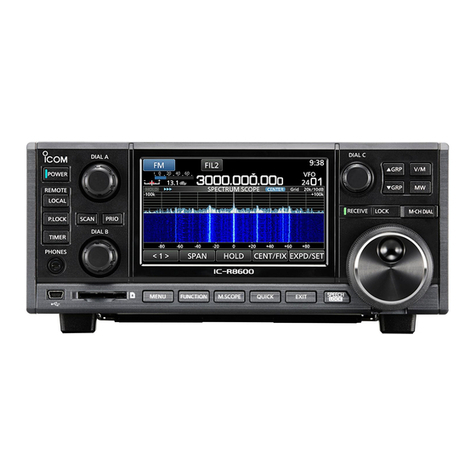
Icom
Icom IC-R8600 User manual
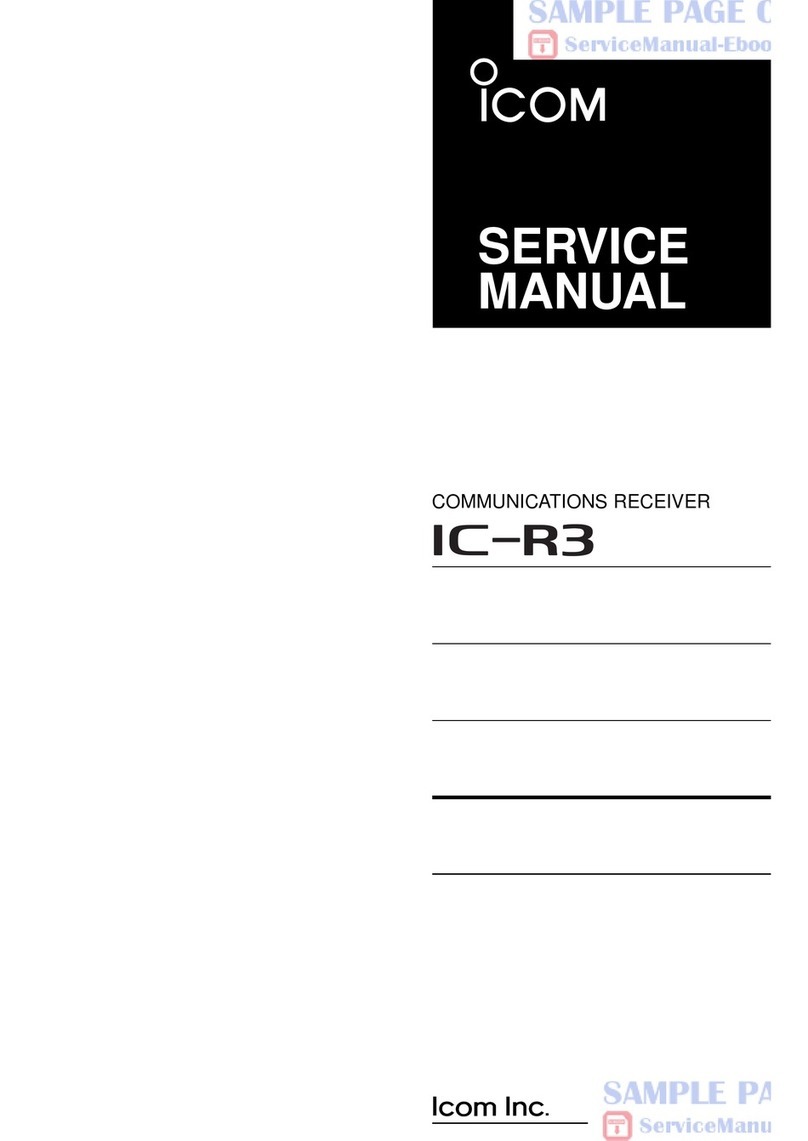
Icom
Icom COMMUNICATIONS RECEIVER IC-R3 User manual
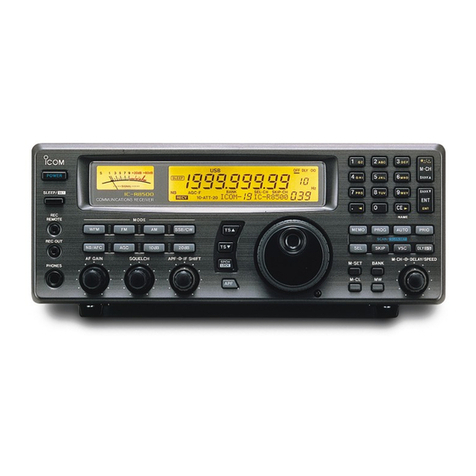
Icom
Icom iC- r8500 User manual
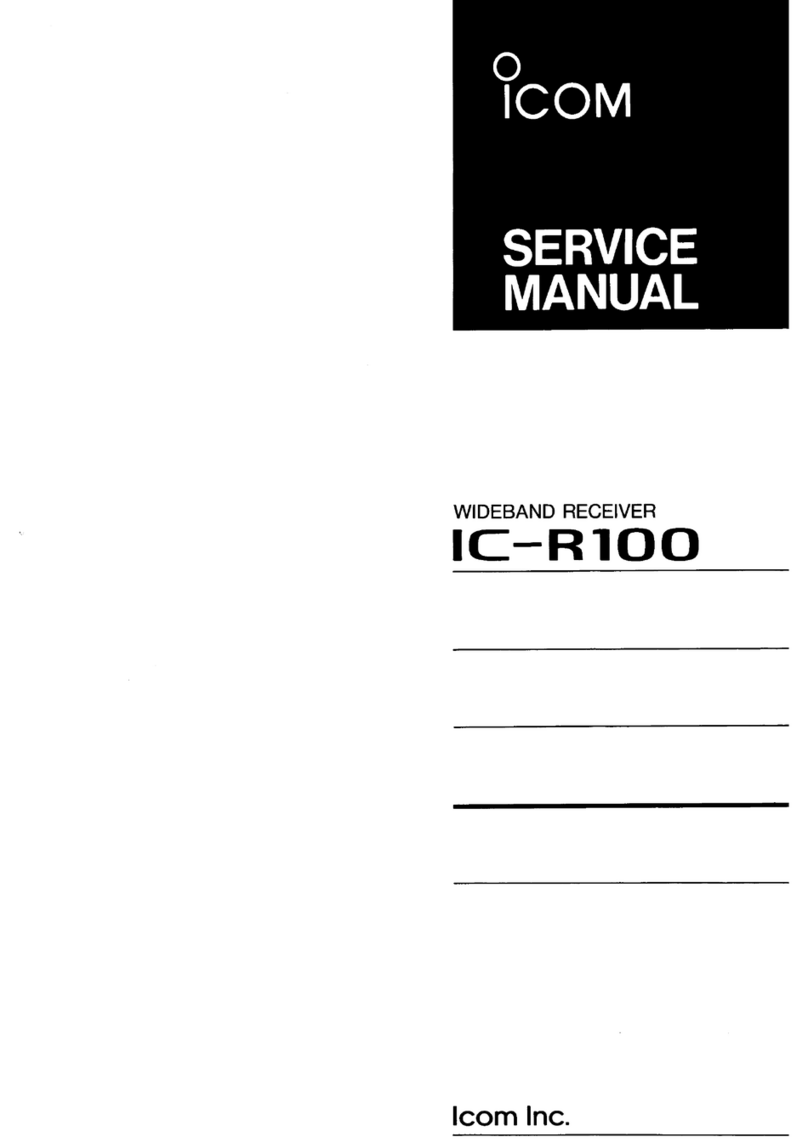
Icom
Icom IC-R100 User manual

Icom
Icom IC-RX7 User manual
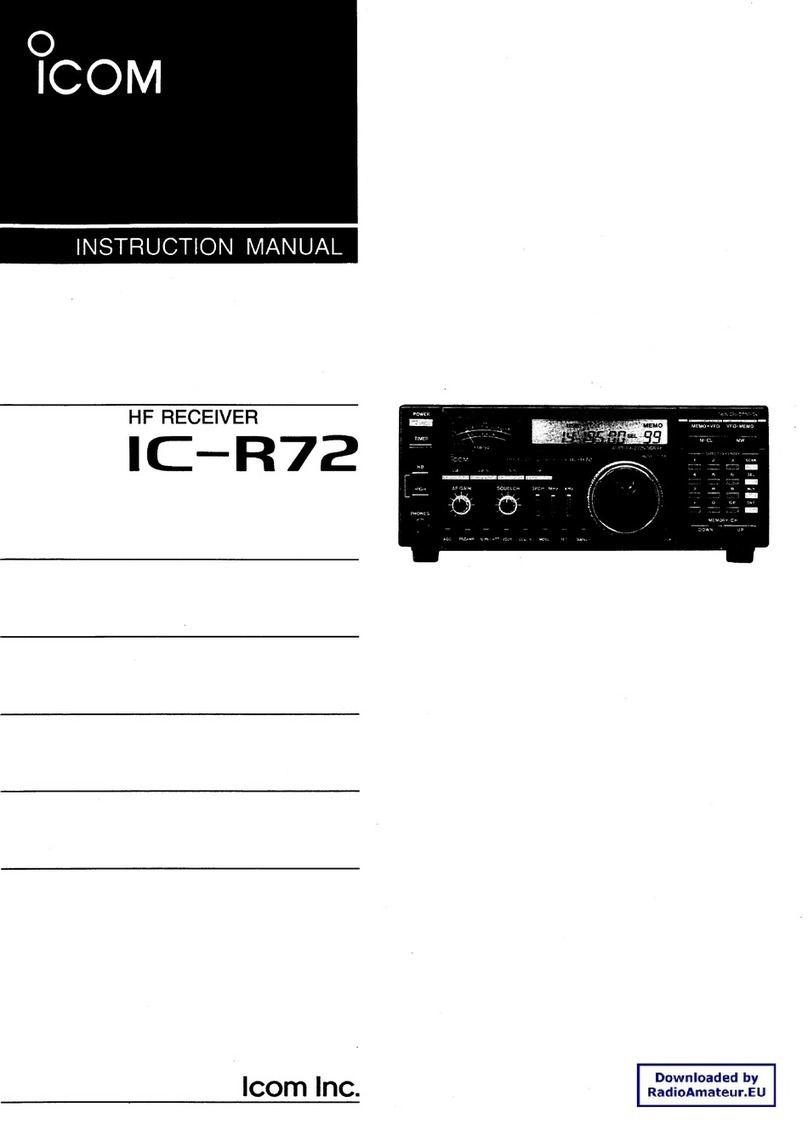
Icom
Icom IC-R72 User manual
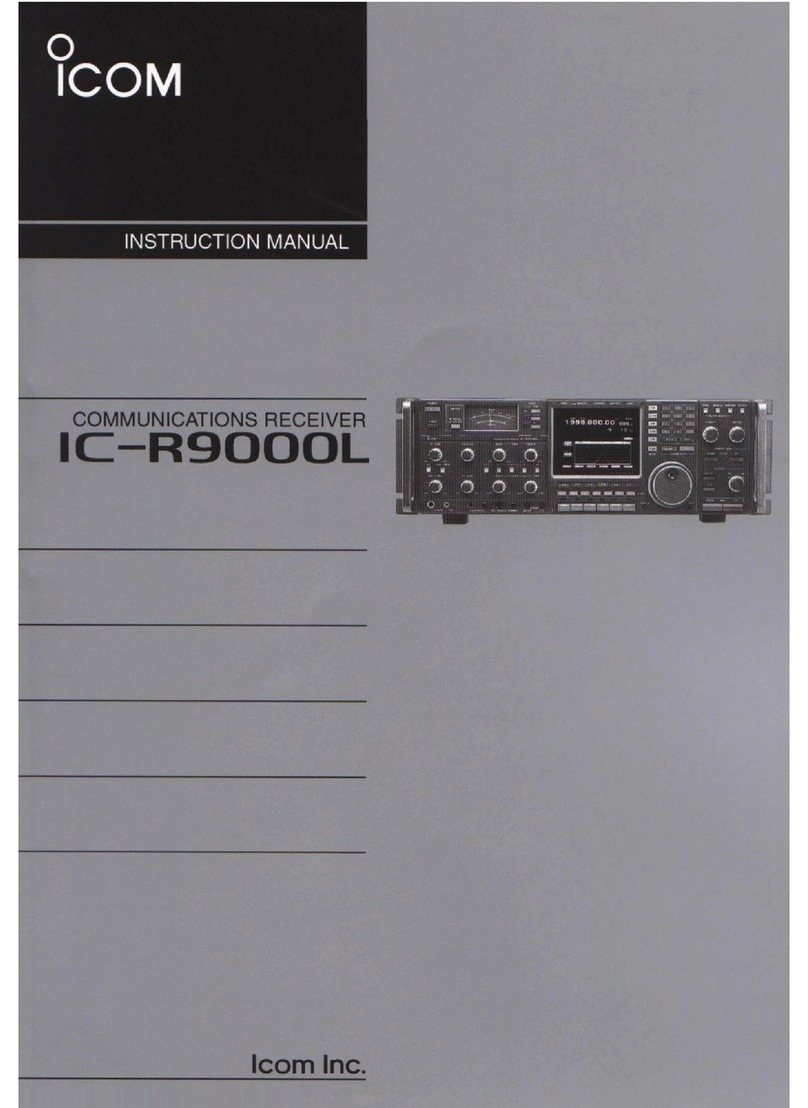
Icom
Icom IC-R9000L User manual
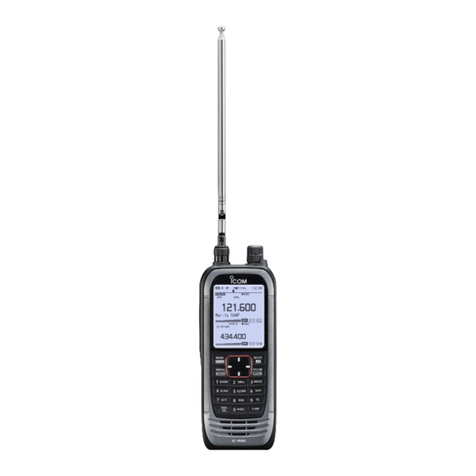
Icom
Icom IC-R30 Installation guide
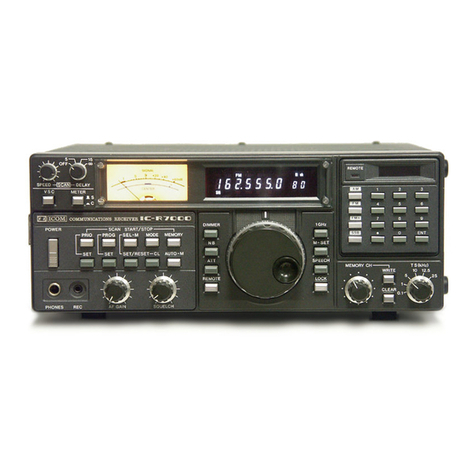
Icom
Icom IC-R7000 User manual
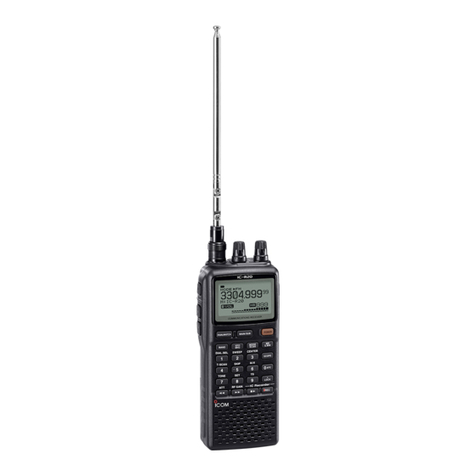
Icom
Icom IC-R20 User manual
